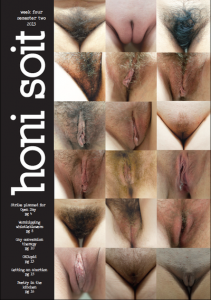The day a student newspaper published vulvas on its cover.
One afternoon late last year, during the lunch break of a boring data entry job in downtown Sydney, a friend gave me an unexpected tip-off- that the next cover of my student newspaper, Honi Soit, would include 18 vulvas. I immediately texted a friend of mine who was an editor of the paper whether this was true, and, five hours later, received a one-word reply- “Yes”.
The spoiler didn’t ruin the experience for me and I was as shocked as anyone when it came out. The controversy didn’t take long to begin. Upon receiving legal advice from the Student Representative Council that this might constitute a criminal offence for public obscenity, the editors placed black bars over each of the vulvas.
Strangely enough, upon publication, these black bars were found to be too transparent and thus, a few hours later, all papers were recalled from their stands and could subsequently only be released upon presentation of an ID to prove one was over 18. It didn’t take long for the story to hit national papers, and eventually the Huffington Post and the Guardian, let alone huge discussion among the blogosphere.
Why would the editors of a student newspaper decide to publish a cover with 18 vulvas, and why would 18 women, including some within the editorial team, agree to be photographed to this end?

Photo: Honi Soit
The editorial team of Honi Soit, for better or worse, is elected as a group by students at elections organized by the Student Representative Council. Most of these elections have two competitive “tickets” facing off against each other by promoting a distinct culture. That year, the “JAM for Honi” ticket had won the election by a respectable margin, presumably with a mandate to push the boundaries of student journalism by returning to its activist roots.
This act did not have the feel of counter-cultural power-protest that burning bras or even Pussy Riot embodied, but was intended as an assertive claim to public space by the women involved. It was not intended to be sexual, but rather counter the banality of violence and oppression that women experience with a correspondingly banal image of that female bodily organ that deserves to be seen and acknowledged, and not in the censored or mystified form that men often portray it as.
There had been many articles published with explicitly political ends that took the body, both as political object and subject, as its starting point. It was a year when the feminist slogan “the personal is political” was taken very seriously indeed. These included- accounts of trauma, discrimination and abuse taking place in various subcultures, including the electronic music scene, gay conversion camps, and the sex work industry.
There were also articles on personal experiences with euthanasia and abortion. Elsewhere, precedent could be found in a 1993 edition where the editorial team of Honi Soit had published a penis on a cover.
It would be hard for a purely career-minded student to understand the decision to participate in the vagina cover. Yet the women involved knew that at stake was something more fundamental than their careers- their bodies. One of them went to speak at a forum in which she discussed how the notoriety from such an act might have affected her law career, yet in narrating her encounters with prying male interviewers and online trolls, she made it clear that her experience of being exposed to judgment and harassment was not unlike that of swathes of women across society.
The battle for censorship rages on, and the newspaper nowadays focuses more on campus culture alongside the alarming state of Australian politics, but the courageous statement made by these 18 women continuous to spark debate across university campuses and beyond.






